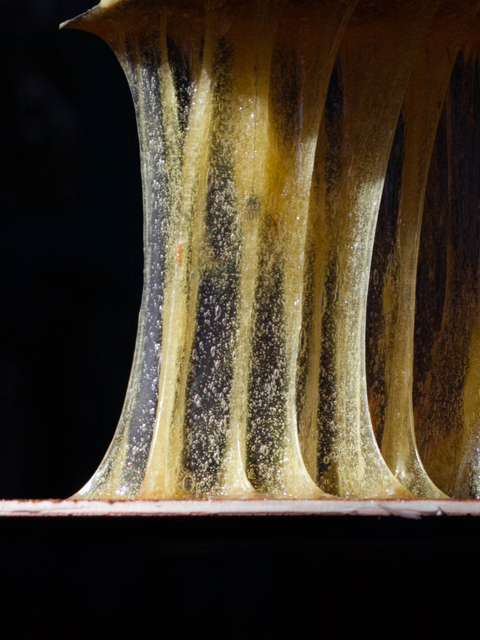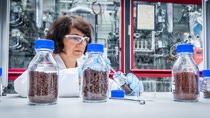Who we are
Anna Maria Cristadoro
Just about every product consists of different, inseparable building blocks. If we could separate these components from one another like Lego bricks and reassemble them, we would be a significant step closer to a circular economy. This is the field of work in which expert Anna Maria Cristadoro and her team are conducting research. She wants to enable better recycling of plastic waste and is firmly convinced that we can use chemistry to solve many of our current challenges.
What are you working on right now in the lab with your team?
I do research on polyurethanes, which are very versatile plastics or synthetic resins that are used, for example, to make mattresses, shoe soles or adhesives. We are all confronted with adhesives on a daily basis, because at the end of the day almost everything consists of different materials that are bonded together - whether it's packaging in the supermarket, in the car or in our shoes. This has one disadvantage: once the adhesives have cured, the bonds are almost impossible to break, and it is impossible to recycle the material without leaving residues. We are working on a solution called "debonding-on-demand" - a kind of smart adhesive that stops bonding as needed. This allows the separated components to end up in the right recycling stream and be recycled.
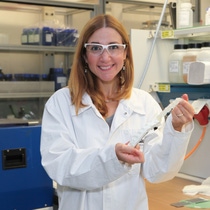
Anna Maria Cristadoro is researching how adhesives can be selectively redissolved to enable better recycling.
How does this "unsticking at the touch of a button" work?
In our society, different materials are usually bonded together so tightly that the products last forever. As consumers, we want products that are durable and never break. That's what new materials are supposed to do while we use them, too, and only "debond" - that is, split into their individual components - in the recycling process. To do this, we build a trigger into new adhesives that senses when the material is in the recycling system. For example, this trigger uses temperature, a chemical reaction, or both as a clue and then dissolves the adhesive. One possible application is shoes. Together with designers and other partners, we are researching solutions to separate individual elements such as the sole, cap, and textiles.
What can we do as consumers?
The best "debonding-on-demand" adhesive is no use if the sneaker ends up in the forest. Each of us should contribute to using our waste as a source of new things by separating and disposing of it properly. Chemistry then enables the process to continue. We are working hard in research together with universities, our customers, and other partners to find solutions for a circular economy with better recycling. For example, by designing materials from the molecule up so that they can be easily recycled, or we design recycling processes so that they consume as little energy as possible. To tackle sustainability properly, we definitely need to start at several points and combine different expertise.
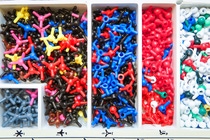
Anna Maria Cristadoro has a vision of a circular economy in which we can separate and reassemble molecules like building blocks.
Have you ever had a real moment of happiness in the lab?
As a native of Sicily, after completing my doctorate on biodegradable polymer groups in Italy, my path led me to BASF in Ludwigshafen, and from there to the U.S. and now to Lemförde, in the north of Germany. One of the best moments for me was when I developed a liquid polymer additive in Ludwigshafen, which was then applied in a specific formulation in the USA. It was a biodegradable dispersant for agricultural products. My task in the USA was then to accompany the production of this new product all the way to the customer. So, I was very fortunate to be there for the whole process and to see how the final product then actually had the desired properties that I had been researching in the lab with the liquid solution. That's when I felt that I was exactly right in what I was doing.
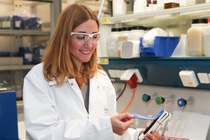
Being courageous pays off: Anna Maria Cristadoro is convinced that even setbacks ultimately bring you one step closer to the goal.
You know the entire process from the first idea to the new product. What is your most important insight?
I think you have to be aware that many ideas and attempts will not work. We must not be discouraged by this. Because every result, even a negative one, brings us a little closer to a solution. And the best idea is always one of many. We researchers need to find out what works and what doesn't. To do this, we have to be courageous and also take paths that may not lead to the goal. When an idea starts to take off and works, and I can gradually get more and more people excited about it, that motivates me a lot. And only with motivation and together as a team can we be successful.

What made you want to become a researcher?
Even as a small child, I mixed all kinds of things in my mom's kitchen and was fascinated by how the substances reacted and changed color, for example. Later, it became clear to me what power chemistry has and what positive changes it enables in our everyday lives and in our world. So, it was clear to me that I wanted to do chemistry - with a connection to materials science. It fulfills me to be able to hold the result of chemical changes in my hand. After graduating from university in Italy and doing my doctorate in Mainz, I started working in research at BASF in 2008 and have worked there since at various sites. The chemical industry is my absolute feel-good place. Here I can contribute to improving things and creating something new.
Does your spirit of research and curiosity also make itself felt in your private life?
In the moments when I come down and reflect, for example when I'm playing with my twins or baking, the best ideas often come to me. I'm very connected to my work and wouldn't be where I am today without the fun I get from research. I carry this over into my private life as well, because I can't help but pass on my enthusiasm for chemistry. I also do this, for example, in the vacation program for the children of my colleagues. Children often see more possibilities than adults, and their openness and curiosity with which they absorb information shows me that anything is possible.
More Information
- Become a smart scientist yourself? The world needs innovation. We need you.Have a look at open positions now.
